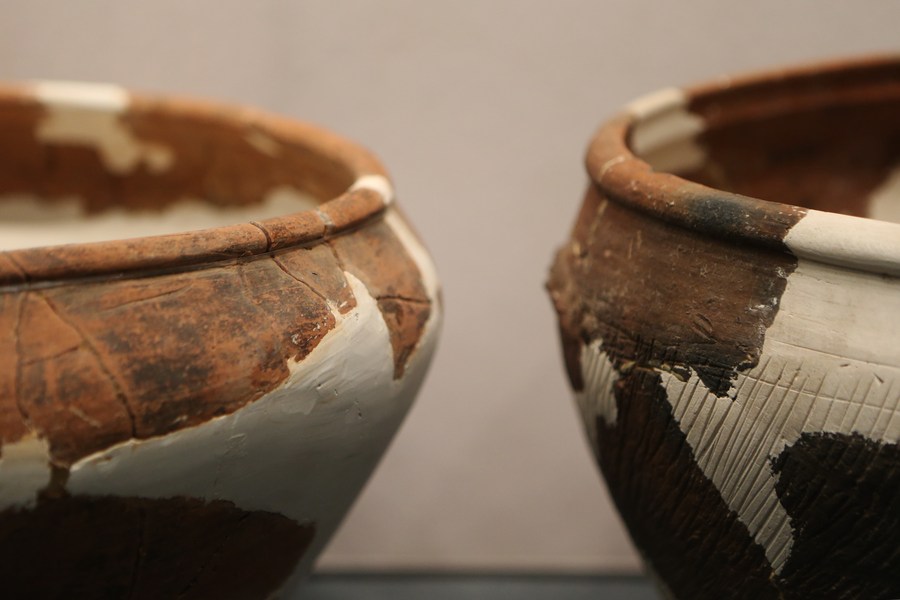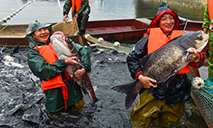Archaeologists unearth evidence of cultural exchange 5,000 years ago

Photo taken on Oct. 15, 2021 shows exhibits at Yangshao Culture museum in Mianchi County, central China's Henan Province. (Xinhua/Xu Yanan)
ZHENGZHOU, Dec. 21 (Xinhua) -- Archaeologists conducting excavations at the Suyang relics site in Henan Province, central China, have found evidence of exchanges between different cultures in remote antiquity.
During the course of six months, relics were unearthed showing that Yangshao Culture was dominant at the site, but the Qujialing Culture and Hongshan Culture were also present, illustrating their interaction in the central plains region thousands of years ago.
The Suyang site, which spans more than 600,000 square meters in Zhangwu Township in the city of Luoyang, has relics including painted pottery pieces and stone tools, scattered in the fields and roads in Suyang Village.
Ren Guang, director of the prehistory research office of Luoyang City Cultural Relics and Archaeology Research Institute, described the site as a large settlement with a natural moat on its eastern and western sides, and a man-made one inside. It mainly belongs to the Yangshao Culture, which dates back between 5,000 and 7,000 years, and originated around the middle course of the Yellow River.
However, archaeologists have also discovered artifacts with strong characteristics of Qujialing Culture, which existed between 3300 B.C. and 2600 B.C. in the middle reaches of the Yangtze River, and a stone sculpture of an animal head featuring elements of Hongshan Culture dating back between 5,000 and 6,500 years in northeast China.
Experts believe that the finds provide valuable materials for studying the influence that Qujialing Culture's northward advance exerted on the central plains region, and reflect the exchanges and integration of the civilizations cradled in the Yellow River and Yangtze River regions.
Zhang Hai, vice director of the School of Archaeology and Museology, Peking University, said that several well-preserved housing sites dating back to the middle Yangshao Culture period provide important materials for research into the architectural techniques and culture of the middle and late Neolithic Age in the area surrounding Luoyang.
So far, archaeologists have cleared 11 housing sites, 126 pits and caves, and one moat. The unearthed relics are mainly pottery, stoneware and bone objects.
"What is most surprising about the Suyang site is the convergence of different civilization elements at the same site," Zhang said, adding that such a phenomenon is a significant feature of the emergence of early Chinese cities.
The professor noted that among the artifacts found in the pits, the majority consists of pottery with the hallmarks of Qujiangling Culture, including tripod basins and pots, as well as painted pottery spinning wheels.
These items indicate that China's central plains area in the late Yangshao Culture period witnessed cultural communication between Qujialing Culture and Yangshao Culture, he said.
A stone sculpture resembling a tiger's head shows many similarities with a "yue" axe-shaped weapon unearthed at a Hongshan Culture relics site in the northeastern province of Liaoning. The weapon was of a type used for rituals in ancient China.
"It basically proves that there existed close communication between Yangshao Culture and Hongshan Culture, and it likely happened in the upper classes," Zhang said.
The Suyang relics site is located on a track along the ancient Silk Road. Archaeologists initiated the excavation work in June and dug 800 square meters in the preliminary stage.
Photos
Related Stories
- Lajia Ruins in NW China's Qinghai a proof of prehistoric civilization
- Sanxingdui cultural relics displayed in Hangzhou attract visitors
- Remains of 5,000-yr-old alcohol, silk found in central China
- New finds at Sanxingdui Ruins show creative power in ancient China
- Spanning four continents, a glimpse of civilizations through gold masks
Copyright © 2021 People's Daily Online. All Rights Reserved.










